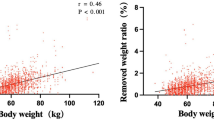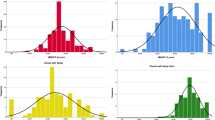Abstract
Breast reduction is a highly emotional topic, involving three conflicting interests: (a) women suffering from symptomatic macromastia, (b) health insurance companies, and (c) surgeons. Many insurance companies, including those in Austria, cover (if at all) only breast reductions with a minimum resection weight of 500 g per breast, irrespective of the physical build of the woman involved. We retrospectively reviewed 136 patients' charts from both cosmetic and reconstructive breast reduction operations and compared the breast resection weight to various parameters of body proportions such as height, weight, body mass index (BMI), and body surface area to determine the parameter best correlated to the weight of breast tissue resected. From this we developed a graded scale for guiding future operations irrespective of a woman's body build. The resection weight ranged from 55 to 1530 g (mean 450±266, median 406); mean BMI was 25.1. The arbitrary 500 g breast resection rule discriminates against women of nonaverage weight or height: of 24 patients (18%) with a cosmetic indication 4 had more than 500 g breast tissue resected bilaterally, while in 62 reconstructive patients (46%) less than the arbitrary 500 g breast tissue was resected. The parameter best correlated to the mean weight of breast tissue resected (sum of both breasts) was BMI. We therefore suggest using the BMI as the basis for a graded weight resection guideline for reconstructive breast reductions. The BMI-based scale treats equally women of all types of body build. In women with a BMI greater than 30 (classified as adiposity) we recommend that breast reduction be postponed, and a general body weight reduction program be undertaken for the sake of a higher impact on general well-being.

Similar content being viewed by others
References
Beer GM, Morgenthaler W, Spicher I, Meyer VE (2001) Modifications in vertical scar breast reduction. Br J Plast Surg 54:341–347
Boschert MT, Barone CM, Puckett CL (1996) Outcome analysis of reduction mammaplasty. Plast Reconstr Surg 98:451–454
Coakley EH, Kawachi I, Manson JE, Speizer FE, Willet WC, Colditz GA (1998) Lower levels of physical functioning are associated with higher body weight among middle-aged and older women. Int J Obes Relat Metab Disord 122:958–965
Dabbah A, Lehman JA, Parker MG, Tantri D, Wagner D (1995) Reduction mammaplasty: an outcome analysis. Ann Plast Surg 35:337–341
Damush TM, Stump TE, Clark DO (2002) Body-mass index and 4-year change in health-related quality of life. J Aging Health 14:195–210
Davis GM, Ringler SL, Short K, Sherrik D, Bengtson BP (1995) Reduction mammaplasty: long term efficacy, morbidity, and patient satisfaction. Plast Reconstr Surg 96:1106–1110
DeWaard F (1978) Body mass index. J Chronic Dis 31:129
Ferreira MC (2000) Evaluation of results in aesthetic plastic surgery: preliminary observations on mammaplasty. Plast Reconstr Surg 106:1630–1638
Gonzalez F, Walton RL, Shafer B, Matory WE, Borah GL (1993) Reduction mammaplasty improves symptoms of macromastia. Plast Reconstr Surg 91:1270–1275
Kerrigan CL, Collins ED, Striplin D, Kim HM, Wilkins E, Cunningham B, Lowery J (2001) The health burden of breast hypertrophy. Plast Reconstr Surg 108:1591–1599
Kerrigan CL, Collins ED, Kim HM, Schnur PL, Wilkins E, Cunninhgam B, Lower J (2002) Reduction mammaplasty: defining medical necessity. Med Decis Making 22:208–217
Klassen A, Fitzpatrick R, Jenkinson C, Goodacre T (1996) Should breast reduction surgery be rationed? A comparison of the health status of patients before and after treatment: postal questionnaire survey. BMJ 313:454–457
Lettermann G, Schurter M (1980) The effects of mammary hypertrophy on the skeletal system. Ann Plast Surg 5:425–431
Miller AP, Zacher JB, Berggren RB, Falcone RE, Monk J (1995) Breast reduction for symptomatic macromastia: can objective predictors for operative success be identified? Plast Reconstr Surg 95:77–83
Roucher R, Drevet JG, Auberge T (1990) Reduction mammaire et abdominoplastie: effet preventif et therapeutique sur la douleur rechidienne chez la famme. Ann Chir Plast Esthet 35:228–232
Schnur PL, Hoehn JG, Ilstrup DM, Cahoy MJ, Chu C-P (1991) Reduction mammaplasty: cosmetic or reconstructive procedure? Ann Plast Surg 27:232–237
Schnur PL (1999) Reduction mammaplasty—the Schnur sliding scale revisited. Ann Plast Surg 42:107–108
Seitchik MW (1995) Reduction mammaplasty: criteria for insurance coverage. Plast Reconstr Surg 95:1029–1032
Strombeck JO (1964) Macromastia in women and its surgical treatment. Acta Chir Scand Suppl 3431:1–16
Author information
Authors and Affiliations
Corresponding author
Rights and permissions
About this article
Cite this article
Kompatscher, P., von Planta, A., Seifert, B. et al. A body mass index related scale for reconstructive breast reduction. Eur J Plast Surg 26, 202–206 (2003). https://doi.org/10.1007/s00238-003-0506-9
Received:
Accepted:
Published:
Issue Date:
DOI: https://doi.org/10.1007/s00238-003-0506-9




